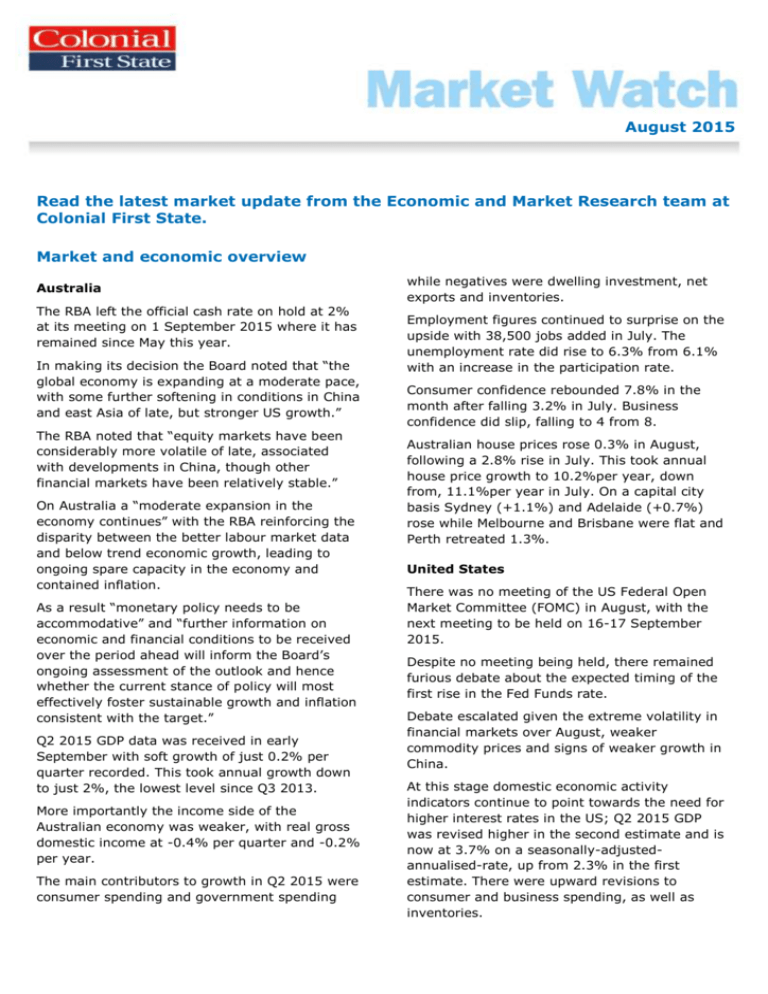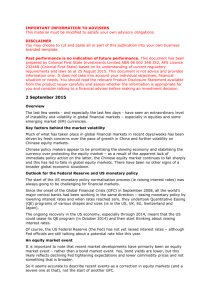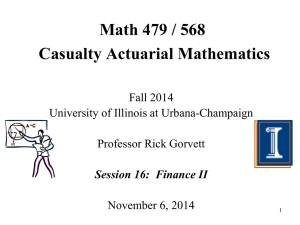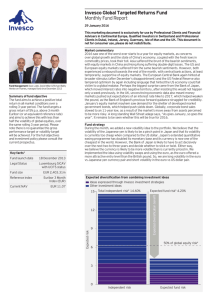Market Watch - Colonial First State
advertisement

August 2015 Read the latest market update from the Economic and Market Research team at Colonial First State. Market and economic overview Australia The RBA left the official cash rate on hold at 2% at its meeting on 1 September 2015 where it has remained since May this year. In making its decision the Board noted that “the global economy is expanding at a moderate pace, with some further softening in conditions in China and east Asia of late, but stronger US growth.” The RBA noted that “equity markets have been considerably more volatile of late, associated with developments in China, though other financial markets have been relatively stable.” On Australia a “moderate expansion in the economy continues” with the RBA reinforcing the disparity between the better labour market data and below trend economic growth, leading to ongoing spare capacity in the economy and contained inflation. As a result “monetary policy needs to be accommodative” and “further information on economic and financial conditions to be received over the period ahead will inform the Board’s ongoing assessment of the outlook and hence whether the current stance of policy will most effectively foster sustainable growth and inflation consistent with the target.” Q2 2015 GDP data was received in early September with soft growth of just 0.2% per quarter recorded. This took annual growth down to just 2%, the lowest level since Q3 2013. More importantly the income side of the Australian economy was weaker, with real gross domestic income at -0.4% per quarter and -0.2% per year. The main contributors to growth in Q2 2015 were consumer spending and government spending while negatives were dwelling investment, net exports and inventories. Employment figures continued to surprise on the upside with 38,500 jobs added in July. The unemployment rate did rise to 6.3% from 6.1% with an increase in the participation rate. Consumer confidence rebounded 7.8% in the month after falling 3.2% in July. Business confidence did slip, falling to 4 from 8. Australian house prices rose 0.3% in August, following a 2.8% rise in July. This took annual house price growth to 10.2%per year, down from, 11.1%per year in July. On a capital city basis Sydney (+1.1%) and Adelaide (+0.7%) rose while Melbourne and Brisbane were flat and Perth retreated 1.3%. United States There was no meeting of the US Federal Open Market Committee (FOMC) in August, with the next meeting to be held on 16-17 September 2015. Despite no meeting being held, there remained furious debate about the expected timing of the first rise in the Fed Funds rate. Debate escalated given the extreme volatility in financial markets over August, weaker commodity prices and signs of weaker growth in China. At this stage domestic economic activity indicators continue to point towards the need for higher interest rates in the US; Q2 2015 GDP was revised higher in the second estimate and is now at 3.7% on a seasonally-adjustedannualised-rate, up from 2.3% in the first estimate. There were upward revisions to consumer and business spending, as well as inventories. The second estimate of Q2 2015 GDP was unchanged at 0.7%per quarter and 2.6%per year. The unemployment rate held steady at 5.6% for the three months to June 2015. Average weekly earnings excluding bonuses was recorded at 2.8%per year to June. Japan The Bank of Japan's (BoJ) policy board convened on 7 August 2015 and left its qualitative and quantitative easing (QQE) program at an annual increase of ¥80trillion to its monetary base. 1.0000 70.00 0.8000 60.00 0.6000 50.00 0.4000 40.00 0.2000 30.00 0.0000 TWI (LHS) 2015 80.00 2013 The Bank of England (BoE) left policy unchanged at its 6 August 2015 meeting, as expected. The Bank Rate was unchanged at 0.5% and the stock of asset purchases remained at £375bn. There was one dissent on the nine member board, the first since December 2014. Market expectations continue to point towards the first hike in the Bank Rate in Q1 2016. 1.2000 2011 United Kingdom 90.00 2009 EU Finance Ministers agreed to a €86bn third bail-out package for Greece. This allowed Greece to receive the first tranche of funding from the European Stability Mechanism in time to repay the European Central Bank its bond maturing. AUSTRALIAN DOLLAR DOWN SHARPLY 2007 The European Central Bank (ECB) did not meet in August. The main refinancing rate remains at 0.05% and a target of €60bn of securities are to be purchased each month. 2005 Europe As with other markets, foreign exchange markets traded with volatility. The Australian dollar finished down 2.7% against the USD in August to $US0.7113 and finished the month on its lows. This is the lowest level since April 2009 and reflects ongoing growth concerns in China, weaker commodity prices and the anticipated first interest rate hike in the US. 2003 Despite these comments, and reasonable domestic economic data, there remained at the end of August only a 42% chance of a rate hike priced in for the September meeting. Australian dollar 2001 Despite below target inflation, comments from Vice Chairman Stanley Fischer at the annual Jackson Hole Symposium suggested “given the apparent stability of inflation expectations, there is good reason to believe that inflation will move higher as the forces holding down inflation dissipate further.” The preliminary estimate of Q2 2015 GDP was released, with growth negative in the quarter at 0.4% per quarter. While this was slightly better than consensus expectations it was still a disappointing result. Weak consumption, which fell 0.8% per quarter, was the main cause and the recovery in exports has taken longer than expected despite falls in the yen. 1999 On employment, there were further positive signs in the month with 215,000 jobs added in the month of July. The unemployment rate held steady at 5.3% over the month. Despite continued improvements in the labour market, average hourly earnings remain subdued, rising to 2.1%per year, from 2.0%per year. AUD/USD (RHS) Source: Bloomberg as at 31 August 2015 Commodities Commodity prices traded with extreme volatility in August, weighed down by the escalating growth concerns in China. The iron ore price and oil price also rose in August. Most metal prices were weaker in August, reflecting financial market volatility and China growth concerns. Tin (-12.9%), nickel (-8.9%) and zinc (-5.6%) were the weakest performers. Copper (-1.8%) and aluminium (-0.9%) also fell while lead (+1.8%) and gold (+3.6%) were higher. Adviser use only IRON ORE PRICE WEAKER 200 challenging. Self-help initiatives, including an ongoing focus on costs, remain on the agenda for most ASX-listed companies. On the whole, companies continued to increase dividends to income-hungry investors. The average dividend payout ratio among ASX 200 companies has reached 75%. Dividend payouts are rising at a quicker pace than earnings, suggesting companies are satisfying investors’ demand for income rather than reinvesting profits for growth. 150 100 50 0 Listed property Source: Bloomberg as at 31 August 2015 GOLD LOWEST IN FIVE YEARS Gold ($US per Troy Ounce) 2000 1800 1600 1400 1200 1000 800 600 400 200 0 2001 2003 2005 2007 2009 2011 2013 2015 Source: Bloomberg as at 31 August 2015 Australian equities The Australian equity market had its most volatile month for nearly four years in August. The S&P/ASX 200 Index closed the month 7.8% lower after trading in a wide range. The Index had fallen by around 12%, before recovering some of these losses in the last few days of the month. Sentiment towards equities globally remained fragile, partly reflecting a heavy sell-off in the Chinese stock market. Chinese economic indicators also gave investors cause for concern. Given China accounts for more than a quarter of Australian exports, the pace of growth is important for ASX-listed companies. Domestically, most ASX-listed companies announced their results for the six or 12 months ending 30 June 2015. Consensus earnings expectations for FY16 declined modestly during the ‘reporting season’, with most companies suggesting that trading conditions remain Australian property securities also weakened in August, albeit by much less than the broader market. The S&P/ASX 200 Property Accumulation Index returned -4.1%, but is still up more than 14% over the past year. Most companies announced results for the six or 12 months ending 30 June. There were few real surprises in the releases. Offshore property securities were affected by the sell-off in global share markets. The UBS Global Property Investors' Index returned -5.9% in USD terms. Continental Europe was the best performing region, declining by just -0.5%. Hong Kong was the poorest performing region, registering a 12.6% return. Global developed market equities Global developed equity markets traded with extreme volatility in August, led by weaker economic data in China and the move to depreciate the currency. An increase in market volatility was always anticipated ahead of the first lift in official interest rates in the US given this would mark the first increase in rates since 2006 and the start of divergence of central bank policy since the GFC. While debate continues about the exact timing of the first rate rise in the US, markets are expected to trade with volatility around this announcement. All major global equity markets fell in August. Overall the MSCI World Index fell 6.8% in USD terms and 4.3% in AUD terms. The S&P500 (-6.0%), the Dow Jones (-6.2%) and the NASDAQ (-6.7%) finished the month down by off the lows. On 24 August the Dow Jones opened with a large 1089 index point fall at the height of the volatility and recorded its biggest three day fall on record, before recovering into month end. Adviser use only The Chicago Board Options Exchange SPX Volatility Index, a market estimate of future volatility, spiked at 40.7 on 24 August, a level last seen in 2011. Equity markets in Europe were also weaker. In Asia, the Japanese Nikkei 225 fell 8.2% while Hong Kong (-11.8%) recorded sizeable losses given the volatility on the various mainland Chinese equity indices. Singapore also retreated, down 8.1% for the month of August. EQUITY MARKETS MIXED Global emerging markets August was a challenging month for emerging market equities, debt and currencies. Both the issues in China and the anticipated first rate hike in the US have created mass volatility. China, Vietnam and Kazakhstan made changes to their currency regimes over the month, while the Malaysian Ringgit fell 9.2% in the month. Emerging market (EM) equities fell 9.0% (MSCI Emerging Market Index), taking the losses over three months to 17.4%, in US dollar terms. The Shanghai Composite Index lost 12.5% taking returns over 2015 to date to just 0.6%. The government unlike previous falls in June and July did not actively support the equity market. Index = 100 500 400 300 200 100 0 1994 1997 2000 2003 2006 2009 2012 2015 S&P/ASX 200 S&P 500 MSCI World Nikkei MSCI Emerging Market Index Euro Stoxx 50 Index Source: Bloomberg as at 31 August 2015 The Economic and Market Research team Stephen Halmarick Head of Economic and Market Research Belinda Allen Senior Analyst Economic and Market Research James White Senior Analyst Economic and Market Research For more information, visit our website colonialfirststate.com.au/investments, contact your local Business Development Manager or call Adviser Services on 13 18 36, Monday to Friday, 8am to 7pm (AEST). This document has been prepared by Colonial First State Investments Limited ABN 98 002 348 352, AFS Licence 232468 (Colonial First State) based on its understanding of current regulatory requirements and laws as at 9 September 2015. This document is not advice and provides information only. It does not take into account your individual objectives, financial situation or needs. You should read the relevant Product Disclosure Statement available from the product issuer carefully and assess whether the information is appropriate for you and consider talking to a financial adviser before making an investment decision. Adviser use only








